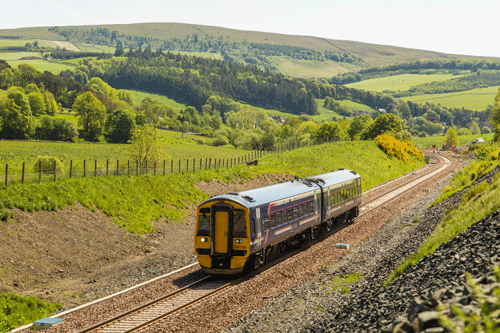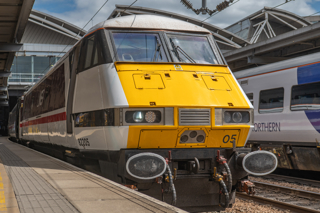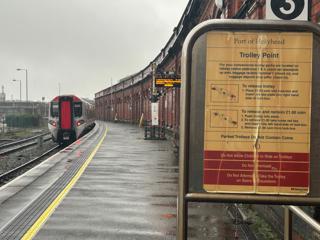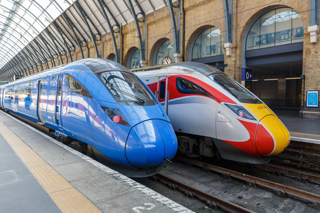History was made at 0845 on September 6, when the first passenger train left the Borders town of Tweedbank bound for Edinburgh Waverley.
ScotRail Alliance Managing Director Phil Verster said that while campaigners may have had their doubts that it would ever happen, the £294 million project is now a reality.
The 1969 closure ripped the heart out of the region. Verster said: “It affected Borders more than any other community.” Speaking on September 4, prior to a special VIP press trip leaving at 1020 for Tweedbank, Verster commented: “Today that changes. It is a new era. It will bring new business opportunities and connect people with jobs. The project itself has led to the creation of thousands of jobs. This project allows people to move to the Borders. The people of Scotland will be able to travel and take in these opportunities and the scenery.”
He later said: “This is an amazing moment. This is not just the opening of a new railway line; it is the opening up of a large part of our country to incredible new opportunities to grow and to prosper.
“For 50 years, people in the Borders have campaigned to have their rail service re-introduced. I’m sure that many people thought over that time that this would never happen. I am so pleased that we have delivered this new line, and so excited about what it will do for the area and for Scotland in general.”
Network Rail Chief Executive Mark Carne says: “I am enormously proud today to see 30 miles of new railway and seven new stations added to Britain’s rail network. The Borders Railway will connect communities along the route to the rest of the country in a way that they have not enjoyed in almost half a century. I look forward to seeing Midlothian and the Scottish Borders prosper economically and socially from this new route in the coming years.
“Personally, I would like to offer my thanks to the project team at Network Rail and our principal contractors BAM Nuttall. They have performed exceptionally to build this railway, on time and on budget and in less than three years, and it sets the standards by which we should measure our project delivery.”
Keith Brown, Cabinet Secretary for Infrastructure, Investment and Cities, speaking on September 4, said: “The excitement is palpable. People can use the train once again.
“It will spread wealth and jobs, and it will provide an alternative to the car. Transport is vital to sustainable growth. The Borders Railway is a true demonstration of good cooperation and collaboration.
“It is the longest domestic railway in more than a century to open. It was done within the timescale and on budget. Before that there was just a litany of campaigns. Network Rail deserves credit for making it happen.
“This area is now on the railway map. That is often not understood. The idea of being on a map is an extremely important one. It opens up communities and allows places to grow. The start of services starts a new phase of regional development.
“We are entering something of a golden age for Scotland’s railways. There is the Stirling-Alloa line. There is 7% growth year on year and 85 million passengers per year.
“There is a new appetite for railways and I hope it continues.”
He added on September 6, when it opened: “Many people have waited a very long time to hear those words and I am proud and excited to be able to say them.
“The communities along the route have now been able to experience their new railway. From today they will be able to make it a part of their everyday lives.
“Scotland’s railways are enjoying a period of success not seen since the time that the old Waverley line was built in the Victorian era, largely thanks to the Scottish Government’s record levels of investment, but also because the people of Scotland see the benefits of rail.
“The Borders Railway will be a real catalyst for growth in the Scottish Borders and Midlothian. It will open up new opportunities for work, leisure, education and business investment for these areas which will, in turn, benefit the wider Scottish economy.
“Today promises to be a busy day for the new line and I look forward to seeing just how many people have turned up to enjoy these first ever ScotRail Borders Railway services.”
Danny Cusick, Senior Director (Food & Drink, Tourism and Textiles), Scottish Enterprise explains: “The impact the railway could have on the Borders region is huge. Four million tourists per year visit the region, spending £1.5 billion. But it is not just tourism where there are huge opportunities; there are other growth opportunities too. Almost 700,000 people live in the region and contribute £21bn to the Gross Value Added (GVA) of the UK. Of the population, 34% have studied at higher education levels, meaning there is a fantastic pool of talent available. The region is home to 27,000 businesses. Between now and 2037, it is expected that there will be an extra 37,000 jobs created there. Over 100 development sites have been identified, and a large housing development at Shawfair is under construction, which also includes retail opportunities.
For those that built it, there is also a sense of pride. Travelling on the launch train on September 4, NR Project Manager Hugh Wark is clearly delighted. He says: “It is great to be here. I first got involved in 2011. That was when Transport Scotland looked to Network Rail to take over. We took on design and scheme development.
“The main thing at that point was that it had gained parliamentary approval. That was important as it gives compulsory purchase orders so we didn’t have to go through that. The land had been purchased already.”
Wark speaks of the main challenges. He says: “The main challenges have been the mining mediation. We had to go under the Edinburgh bypass and also deal with old infrastructure, but we came up with solutions. The environmental challenge was also hard. We had to go through beautiful countryside which is home to badgers, bats and eels that had to be protected and moved.”
He says that he personally has not looked at what will be required to extend the line over the still-closed section to Carlisle, but he suggests that the benefits of political willingness towards railways north of the Border could help.
“Our job was to deliver as specified. Nobody has really looked forward seriously. I believe there is great interest in this, but let’s realise the benefits of this section first. I am sure there will be people pressure to get it extended, and it would be great to see that happen.”
For Wark himself this was the last major project before he retires. He lives in Perth but is looking forward to travelling on the line his team built, and being able to enjoy the sights and sounds of the region.
BAM Nuttall Project Director Nissar Mohammed worked on the Stirling to Alloa re-opening too, but this was much bigger he believes. Speaking on September 4, he explains: “We started in 2011 and construction began in 2012. We designed and built it. It was absolutely on time and within budget. Really, it should have taken twice as long. The cost was £12 million a month and it was a short timescale.
“There were two challenges. One was logistics as there is one main road and the site had to be long and thin because there are sensitive areas with wildlife criteria - there are 92 badger sets.
“Also the level of intensity was an aspect. But the weather has been kind, thankfully. We had an early contract involvement where we had nine months to work out the best delivery campaign. We had contingency plans in place, in case the weather conditions had been adverse.”
The construction completion date was set for June 14, but Mohammed’s team was able to deliver it a week early. That was achieved through managing the supply chain. “We got support from the national supply chain, and also from the Central Belt.”
Speaking on September 4, Mohammed has a beaming smile. He looks out of the train window and says: “This is probably the fifth time I have travelled along the route, and it feels just as good as the first time. I have been in the industry 28 years and this is my biggest project.
“This will increase choices for people. This could be a lifestyle changer.”
Samantha Smith, Borders Railway Blueprint Programme Manager, Scottish Borders Council believes there is a lot more to come. Speaking on September 4, she said: “The original business case is about socio-economic benefits. It is about new jobs and job opportunities and there were always plans to connect communities.”
Smith says that the new railway has two major benefits. “It connects 100 development sites and shortens journey times.”
She says of the Borders: “It is quite a big region. Berwick is at least an hour away. So you can imagine it is a fast connection via public transport compared to the alternative.
“This was the only mainland region with no connectivity.” Of course, there is still the extension beyond Tweedbank that campaigners are pushing for. Smith highlights that Borders Railway Maximising the Impact: A Blueprint for the Future* says: “We will scope potential further feasibility work around extending the Borders Railway towards Hawick and Carlisle, including turning options at and beyond Tweedbank.” She says of a possible extension: “It will have the same impact as this. The benefits will be the same. We will give it serious consideration.”
Smith explains that the Borders economy is, traditionally, based around high-quality textiles, such as Hawick Cashmer. There are bio-sciences in the region too, and she describes both as “key sectors”. But Smith adds: “We are expecting key industries of Scotland, including food and drink, tourism and the creative industries as well as business and financial sectors, to move here.
“We have just launched a new Borders prospectus that showcases the development opportunities.”
She attributes the fact that 34% of people have had access to higher education down to two factors, that the schools in the region are “excellent” and that residents stay local to the area. Even so, 22,000 people commute to Edinburgh each day, and that is an opportunity for the railway.
“There is the main A7 road, and it follows the railway. There is also the A68, but that is it. This , is transformational. It should breathe new life into the Borders and it gives new life to the economy.”
Regarding tourism, Smith is keen to stress that Borders is not a rival destination to the likes of Edinburgh and the Highlands. She says: “We are not saying go to the Borders instead of other destinations. But we are promoting it as another option. It inspired Sir Walter Scott, and it is a very popular cycling destination. Plus we have the world-famous salmon fishing here…”
Mike Cantlay, chairman of VisitScotland, travelled on the VIP train on September 4, and barely contains his enthusiasm. He says of the re-opening: “It is of benefit to everyday business as well as tourism, and it works both ways.
“The tourist opportunity is massive. Edinburgh attracts millions of tourists each year and this gives them easier access to the region.
“The buzz that surrounds the re-opening is great. That the benefit to the economy is £35bn is not the main point - this is about putting the Borders back on the map.
“We are marketing it around the world. I think the level of tourism interest has come as a shock to the Borders. Before this, many people were wondering if anyone would want to come. We ourselves wondered about the interest for the launch, yet photographers were jumping off at stations to take pictures, and there is a train full of journalists.
“There are also steam trains and beautiful scenery. I think the trains will be fully booked, as will be the steam-hauled trains next year too. We may even have capacity issues. The steam trains will have big tourism potential.”
Already trains are full, and the steam specials occasionally clash with booked ScotRail trains, which means the booked service trains are cancelled in favour of the specials. This causes consternation as passengers are not able to use the ‘A4’-hauled trains, despite them being advertised as booked connections. Says Cantlay: “We will have to manage the clashes. The scenic railways and the demand for them is a game changer. Previously people have only seen trains as a means of getting from A to B, but that may now change.”
Many people give credit to the campaigners for the re-opening of the Borders Railway. They worked tirelessly to convice people that the line should be re-opened.
Campaign for Borders Rail called the re-opening “a unique achievement of grassroots campaigning.” CBR argues that the new railway stands out from other recent Scottish line re-openings because its original inspiration, and key elements of the final delivered scheme, came from the ideas and efforts of campaign groups.
CBR’s UK Parliamentary Officer Nick Bethune says: “The Borders Railway should be recognised as one of the greatest achievements of grassroots rail campaigning in British history.
“Other route re-openings in recent years in Scotland - Larkhall, Alloa and Airdrie-Bathgate - have essentially been ‘top down’ schemes, conceived and planned by local and/or central government. But the origins of the railway to Galashiels and Tweedbank can be traced back to the vision of Borders-based Simon Longland back in the early 1990s.
“This led on seamlessly to the founding of CBR in 1998, and under the inspired leadership of our first chairman, Petra Biberbach, campaigners played a big part in persuading Borderers that they really could get their railway back - generating a 17,200 signature petition which was handed to the Scottish Parliament
“There hasn’t been a bigger reversal of a Beeching cut anywhere in Britain, and a whole region that was cut off from the rail network is now back on the railway map. Most other route re-openings have been essentially suburban in character - but the Borders Railway is very different, and nothing quite like this has ever been done before. This is a credit not just to campaigners, but also to local and central government, and to the rail industry.”
Bethune continues: “As well as the core strategic achievement of the return of a railway from Edinburgh through Midlothian to Tweedbank, local rail campaigners can take credit for some important supporting successes, a number of them achieved in the face of official resistance.
“For example, we persuaded Parliament to include a station stop at Stow when none was to be provided, and it was our initiative which led to the saving of the original 1849 station building at Stow from demolition.
“Crucially, years of research and lobbying by us - plus the input of Claudia Beamish MSP - convinced Transport Minister Keith Brown in 2012 that the Tweedbank station track layout should be re-designed to take 12-coach tourist trains, providing the basic infrastructure needed to bring additional tourist spend to the Borders.
“More recently, we persuaded Transport Scotland that the Borders Railway Class 158 trains should be refurbished to provide a better experience for commuters and tourists.
“The new railway offers much more than it would have done without the efforts of hundreds of unpaid campaigners over the last 17 years.”
The mantra at the launch was very much: “The journey begins today, but it will be for the benefit of generations to come.” That sums up the scheme pretty well.
- This feature was published in the Scottish Supplement of RAIL 783 (September 16 - 29 2015)
















Login to comment
Comments
No comments have been made yet.